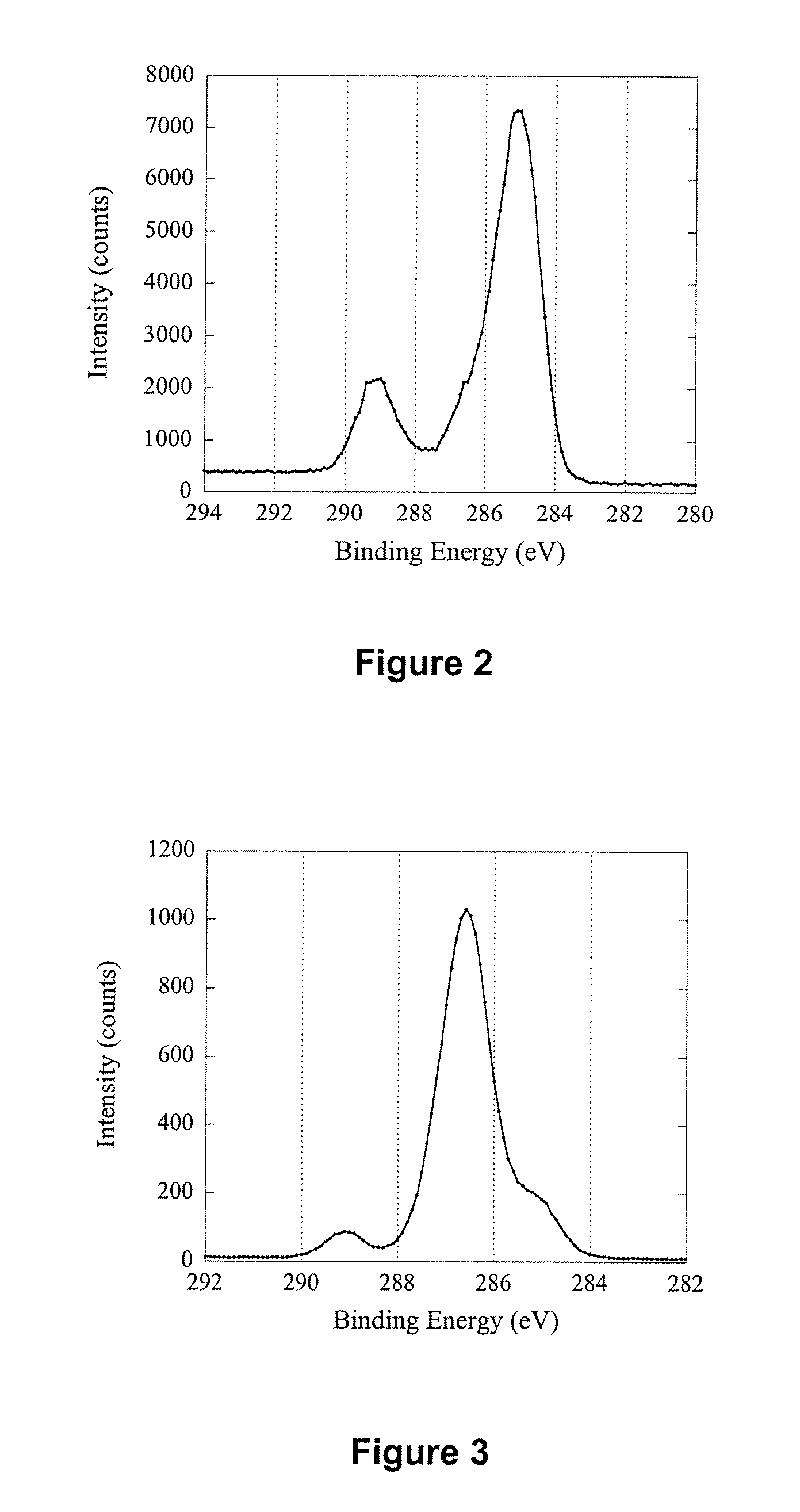Polymeric coatings and methods for forming them
a polymer coating and surface technology, applied in the direction of coatings, liquid surface applicators, pretreated surfaces, etc., can solve the problems of affecting provoking an undesired biological response, etc., to achieve the effect of improving the stability and insolubility of the macromolecular coating, reducing the risk of gastrointestinal
- Summary
- Abstract
- Description
- Claims
- Application Information
AI Technical Summary
Benefits of technology
Problems solved by technology
Method used
Image
Examples
example 1
Deposition of an n-Heptylamine Radio Frequency Glow Discharge (RFGD) Thin Film on Silicon Wafer Substrates
[0176] Silicon wafers (Si) with a size of 1 cm×1 cm were cleaned by sonication in a 2% RBS surfactant solution for 30 min followed by thorough rinsing in Milli-Q™ water and ethanol. After drying with a high velocity, purified N2 stream, the wafers were introduced immediately into a radio frequency glow discharge plasma reactor described elsewhere [Griesser H J., Vacuum 39 (1989) 485]. Deposition of an n-heptylamine plasma polymer (HAPP) thin film was carried out for 30 s at a power of 20 W, a frequency of 200 KHz and an initial monomer pressure of 0.150 Torr. Presented in Table 1 are elemental ratio data before and after HAPP thin film deposition. The elemental ratios were calculated from the surface composition of the two samples obtained using X-ray Photoelectron Spectroscopy (XPS). The first point of interest was that the Si / C ratio was decreased from 12.10 to 0.00 after sur...
example 2
Synthesis of Diethyl-Dithiocarbamic Acid 4-Vinyl-Phenyl Ester
[0177] A solution of sodium diethyldithiocarbamate trihydrate (3.5 g, 1.55×10−2 mol) in 20 mL of ethanol was added to a flask equipped with a stirrer, dropping funnel and a reflux condenser. To this solution was added a solution of 4-vinylbenzyl chloride (3.0 g, 1.96×10−2 mol) and ethanol (5 mL), dropwise, over a period of 0.5 h at a temperature of 0° C. The resultant solution was stirred at room temperature for 24 h before pouring into a large volume of water and extracting with diethyl ether. The ether phase was washed three times with water, dried over sodium sulphate, before finally removing the diethyl ether by evaporation. The residue was recrystallised three times from methanol, giving a yield of 2.6 grams (83%). 1H NMR (CDCl3) δ7.36 (s, 4H, C6H4), 6.70 (dd, J=11.6 and 17.5 Hz, 1H, CH═CH2), 5.73 (d, J=17.5 Hz, 1H, CH═CH2), 5.24 (d, J=11.5 Hz, 1H, CH═CH2), 4.54 (s, 2H, CH2S), 4.04 (q, J=7.3 Hz, 2H, NCH2), 3.73 (q, J...
example 3
Synthesis of a Polymer Containing Carboxylic Acid Moieties and Iniferter Moieties
[0178] Acrylic acid (3.0 g, 4.16×10−2 mol, anhydrous, Fluka) was dissolved in 6 mL of dimethylformamide (DMF) (BDH chemicals), followed by removal of the inhibitor by passage of the solution through a column containing Inhibitor Remover (Aldrich). To the acrylic acid solution was added 1.1 g of diethyl-dithiocarbamic acid 4-vinyl-phenyl ester (4.38×10−3 mol) (from Example 2) and 150 mg of AIBN, following which the solution was purged with nitrogen for 10 min and sealed. Heating overnight at 60° C. resulted in the formation of an opaque, viscous gel which was diluted by further addition of 20 mL of DMF. The solution containing the copolymer was then dialysed (Spectrum Spectra / Por 1 molecular porous membrane tubing, MW cutoff 6000-8000) against DMF overnight. The DMF was changed twice during dialysis. The contents of the dialysis tube were then transferred to a flask and made up to a final volume of 50 m...
PUM
| Property | Measurement | Unit |
|---|---|---|
| thickness | aaaaa | aaaaa |
| thicknesses | aaaaa | aaaaa |
| thicknesses | aaaaa | aaaaa |
Abstract
Description
Claims
Application Information
 Login to View More
Login to View More - R&D
- Intellectual Property
- Life Sciences
- Materials
- Tech Scout
- Unparalleled Data Quality
- Higher Quality Content
- 60% Fewer Hallucinations
Browse by: Latest US Patents, China's latest patents, Technical Efficacy Thesaurus, Application Domain, Technology Topic, Popular Technical Reports.
© 2025 PatSnap. All rights reserved.Legal|Privacy policy|Modern Slavery Act Transparency Statement|Sitemap|About US| Contact US: help@patsnap.com



